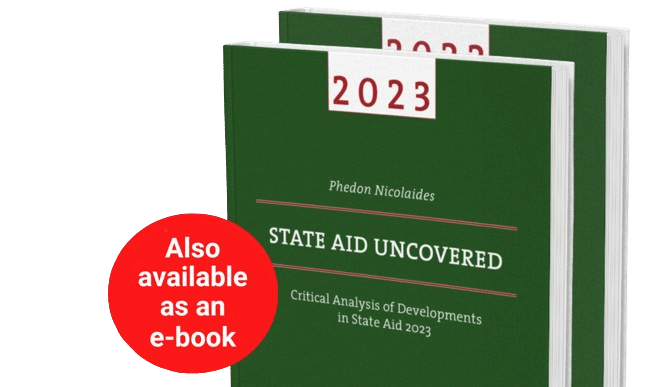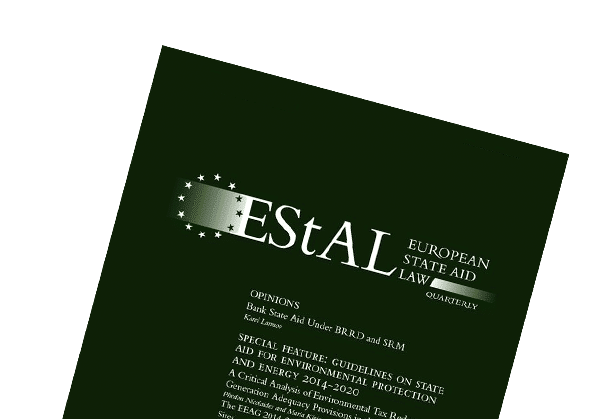
A public authority, acting as a private investor, may provide finance which is free of state aid to an airport and at the same time grant state aid to the same airport. Public funding of activities that fall within the exclusive tasks of the state is not state aid. When a public authority defines the activities that fall within the public remit [the exclusive tasks of the state], it must be consistent. It may not bear their costs at some airports while imposing those costs to the operators of other airports.
Introduction
Leipzig-Halle is certainly the most famous airport in the state aid literature. It must also be one of the most generously funded airport in Europe. I have lost count of the subsidies that have been granted to it. This article examines yet another measure in favour of the airport. The Commission, in decision 2015/1469, found that the measure was partly non-aid, either because it was in conformity with the market economy operator test or because it financed costs falling within the public policy remit. However, part of the measure did constitute state aid which was compatible with the internal market.[1] It is a rich case and the arguments advanced by the German authorities and the responses, mostly rebuffs, of the Commission are worth reviewing in detail.
The measure consisted of three parts: i) shareholder loans, ii) capital injections and iii) infrastructure expansion and improvements. The third part was made up of about 20 different projects ranging from noise abatement to engine testing facilities to expansion of runways.
Economic activities
The first step in the Commission’s analysis was to distinguish between those activities which were economic in nature and those that fell within the exclusive competences of the state. The Commission rejected German arguments i) that the concept of undertaking did not apply to airports, ii) that the construction of airport infrastructure was a general measure pursuing transport, economic and regional policy objectives, iii) that the construction of airport infrastructure was not an economic activity because a private investor would not engage in that activity, iv) that the freedom of action of airports was limited by strict legal obligations and by price regulation and v) that airports had higher fixed costs due to their proportionately larger infrastructure.
The Commission referred extensively to the Leipzig-Halle and the Aerports de Paris judgments to point out that economic activity is defined in connection to the possible existence of markets rather than policy objectives, that airport operations are market-based activities and that airport infrastructure is inseparable from the commercial services offered by airports. [paragraphs 197-205]. With respect, in particular, to the argument that airport charges were regulated, the Commission observed that “the charges have to be established by the airport operator and submitted for approval to the Federal Ministry for Transport. … [A]irport charges are set by the airport operators within the regulatory constrains to avoid any undue discrimination between the airport users and possible abuses of a dominant position of the airport manager. However, the Commission considers that this does not preclude airport managers from setting the level of airport charges taking into account the necessary investments and its costs.” [paragraph 206] Leipzig-Halle, therefore, was an undertaking.
Public remit
The Commission did recognise that certain activities funded by the measure were not economic in nature. Those were the activities that feel under the responsibility of the state in the exercise of its official powers. They included “air traffic control, police, customs, firefighting, activities necessary to safeguard civil aviation against acts of unlawful interference and the investments relating to the infrastructure and equipment necessary to perform those activities”. [paragraph 210]
Then the Commission made two important clarifications. First, “(211) the public funding of such non-economic activities does not constitute State aid, but has to be strictly limited to compensating the costs to which they give rise and may not be used to finance other activities. Any possible overcompensation by public authorities of costs incurred in relation to non-economic activities may constitute State aid. Moreover, if an airport is engaged in non-economic activities, alongside its economic activities, separated cost accounting is required in order to avoid any transfer of public funds between the non-economic and the economic activities.”
Second, “(212) public financing of non-economic activities must not lead to undue discrimination between airports. Indeed, it is established case law that there is an advantage when public authorities relieve undertakings of the costs inherent to their economic activities. Therefore, when it is normal under a given legal order that civil airports have to bear certain costs inherent to their operation, whereas other civil airports do not, the latter might be granted an advantage, regardless of whether or not those costs relate to an activity which in general is considered to be of a non-economic nature.” This is a rather cryptic statement. What could it mean? It appears to mean the following. Member State can decide that a certain activity falls within its prerogatives and can remove it from the realm of the market. For example, a Member State may decide to bear itself the costs of firefighting or may shift those costs to airport operators. Irrespective of where it decides to draw the dividing line between economic and non-economic, it must be consistent. It cannot claim that firefighting is economic in nature for airport A that happens to generate large revenue and can cover its costs, but then pay for firefighting expenses in airport B that has lower revenue and cannot cover all its costs.
Do you know we also publish a journal on State aid?

The European State Aid Law Quarterly is available online and in print, and our subscribers benefit from a reduced price for our events.
In order to establish whether all cost items fell consistently [i.e. across all airports] within the public remit, the Commission examined each one individually against the provisions of several German laws concerning airport operations.
The Commission’s findings were as follows:
Operational safety: It is a normal part of the economic activity of running an airport. Costs related to regulatory requirements and standards do not fall within the public remit. [215]
Runways, taxiways and aprons: They are essential elements for the economic activities engaged in by an airport manager. The construction of runways, taxiways and aprons allows an airport manager to exercise its primary economic activity. [216]
Air traffic control, housing of police, fire station building, firefighting equipment and meteorological services: In principle, the Commission noted that they could be considered to constitute activities falling within the public policy remit. [217] In general, there was no law obliging airport operators to pay for those costs. However, there was an exception to this general state of affairs. The costs of meteorological services were borne by some so-called non-qualifying airports. For this reason, the Commission concluded that Leipzig-Halle, by being classified as a qualifying airport, derived an unfair advantage because it was relieved from those costs. [219, 228-232, 243 & 248]
Heliport for rescue services: It was considered to fall within the public remit. [240]
Acquisition of land, relocation, noise abatement and accompanying landscape conservation planning, engine testing structure: They were all normal costs to be borne by airport operators, despite the fact that airport operators had to conform with the relevant regulatory standards. [222-224]
Taxiway and traversing bridges, extension of runway, planning costs, site clearance, apron expansion, construction of the new aviation terminal and small aircraft shed: They too were considered to be normal costs that could not be dissociated from the operation of an airport. [225-229]
Winter-service equipment & de-icing areas: Germany argued equipment for winter services and additional de-icing areas were necessary for the safe and timely operation of aircraft. Moreover, revenues from the de-icing services did not cover the costs of the necessary infrastructure. The Commission replied that equipment and services for safe operation were part of the normal activities of airports and whether an activity was profitable or not was not decisive. Then it noted that the de-icing services were rendered against remuneration and that they were essential services for airports. It concluded that they were economic in nature. [233-238]
Shareholder loan
“(255) According to its decision-practice, in order to determine whether the [shareholder loan] under assessment was granted at favourable conditions, the Commission may — in the absence of other proxies — compare the interest rate on the loan in question with the Commission reference rate. The Commission’s reference rate is established pursuant to the methodology laid down in the 2008 Reference Rate Communication.”
“(256) The 2008 Reference Rate Communication establishes a method for setting reference and discount rates that are applied as a proxy for the market rate. However, because the Commission reference rate is a proxy, where the Commission has other indicators in a specific case of the interest rate that the borrower could obtain on the market, it may base its assessment on those indicators.”
Leipzig-Halle did not have a credit rating. Since the parent company was liable for the loans obtained by the airport, the Commission took into account the credit rating of the parent. However, the parent company did not have a credit rating either. Nonetheless, it could furnish internal bank ratings. The Commission took the lowest of those ratings [not specified for being commercial secret].
Then in order to determine the quality of the collateral, the Commission calculated the loss given default [LGD]. At this point another problem arose. The loan was short term and was not collateralised. Germany argued that the LGD ought to be less than 30% [which implies a normal collateral] because the liabilities of Leipzig-Halle were less than the value of its assets. The Commission did not accept this argument because the book value of assets is not sufficient for estimating the liquidation value of a company in case of bankruptcy. [265] It considered, instead, that the LGD for unsecured senior debt was 45%. According to the methodology of the 2008 communication on reference rates, when the LDG is in the 30% – 60% range, then the quality of the collateral is categorised as normal.
At this point, the decision merely says that because the loan was not highly collateralised, the credit rating could not be raised by one notch. And then this line of analysis stops. Instead, the Commission went on to perform a benchmarking exercise. It is not clear why it did not continue its previous line of calculations to derive a reference rate. As shown immediately below, the formula is the same but the numbers that are fed in the formula are different.
The Commission examined whether the shareholder loan was in line with market conditions by benchmarking it against rates of risk derived from credit default swap [CDS] spreads. CDS is essentially insurance that one buys to protect itself against default of a debtor. The buyer of the CDS transfers the risk to the seller. The fee [or insurance premium] that the buyer pays, expressed as a percentage of the protected amount, reflects the underlying risk of default of the debtor.
The market conform interest rate of a loan should equal or higher than a benchmark rate which is:
Benchmark rate = base rate [inter-bank offer rate] + risk margin [CDS spread of a company similar to Leipzig-Halle] + administration fee [10-20 bp]
Because the shareholder loan was equivalent to short-term revolving credit facility, the Commission took the 1-year EURIBOR as a proxy for the inter-bank offer rate.
The Commission concluded that the interest rate charged for the shareholder loan was higher than the derived benchmark rate, which meant that there was no state aid element in the loan. [275]
Capital injections
The relevant question was whether the capital injections conformed with the market economy operator test. Germany argued that the capital injections would create 5100 jobs, which was naturally rejected by the Commission because social/economic policy concerns must be ignored. [289] Germany also argued that the MEOT could not apply to airport infrastructure and that implied that investments that that could not be undertaken by the market would fall outside the scope of state aid rules. [291]. The Commission rejected that too. “(292) … The MEO test cannot be excluded just because the private sector would not be involved in financing airport infrastructure. An economically difficult situation does not absolve the public investor from acting as reasonably as a private investor in the same situation would have done. In this context, the Commission notes that the case-law of the Court of Justice of the European Union has clarified that investment in economic activities which would not be undertaken by private investors operating in a market economy can contain State aid elements.”
(293) … The Commission notes that Germany stated that the capital increases were done without an underlying business plan and without long-term prospects for profitability. (294) Despite the inherent and significant uncertainties related to the project, such as the long-term nature of the investment project (around 50 years), there was neither an ex ante business plan, nor a sensitivity analysis nor any underlying profitability assumptions. This is not in line with the type of analysis that a prudent investor would have undertaken for a project of such magnitude. (295) On this basis, the Commission finds that the capital injections [granted to Leipzig-Halle] an economic advantage (to the extent that the investment grants were not purely related to public policy remit activities).”
In other words, the Commission used the MEOT to show that Germany pursued public policy objectives because there was no ex ante plan to determine the long-term profitability prospects of the airport. This is a surprising finding regardless of the fact that Germany acted as a public authority. The pursuit of public policy does not mean that one should ignore the fundamental question whether the public funding is worth the benefits it generates to the region or the 5100 jobs it was claimed it would create in this case. The NPV of the capital injections was EUR 189 million. The investment was not able to generate sufficient revenue to cover both the operating expenses and the initial investment. As a result there was a funding gap whose NPV was EUR 167 million. If we divide this amount by the number of jobs to be created [5100], the subsidy per job comes to about EUR 33,000. This is significantly higher than the average annual salary in the EU. Whether this was an amount well-spent depends on what other job opportunities may have existed and the magnitude of possible positive spillovers.
Compatibility
Having established that the capital injections were state aid for those cost items that did not fall within the public remit, the Commission proceeded to assess their compatibility. It used the common assessment principles as set out in the aviation guidelines but did not apply the full conditions of the guidelines because they did not cover airports for freight transport.
The need and proportionality of the aid was determined by performing a funding gap analysis. The analysis showed that if the infrastructure was entirely financed through loans the airport would not have been able to bear the costs. The aid intensity was 88%. It was derived by dividing the NPV of the funding gap [EUR 167 million] by the NPV of the investment [EUR 189 million].
————————————————————————————————————————————–
[1] The full text of the Commission decision is published in OJ L232 of 4 September 2015. It can be accessed at:
http://eur-lex.europa.eu/legal-content/EN/TXT/PDF/?uri=CELEX:32015D1469&from=EN


